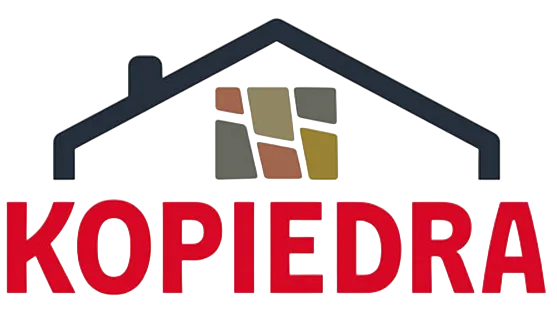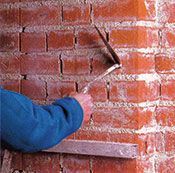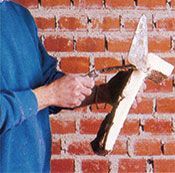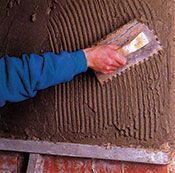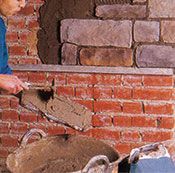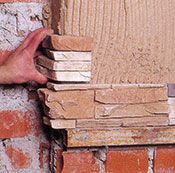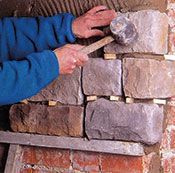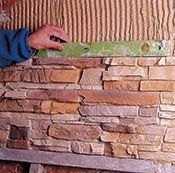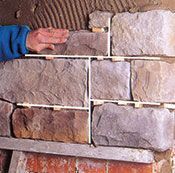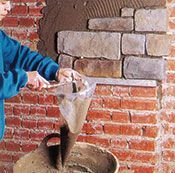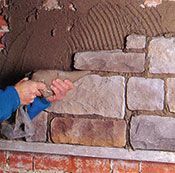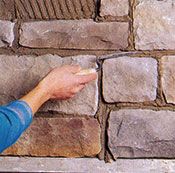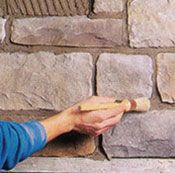Installation of artificial stone in Madrid
How to install your Kopiedra stone step by step
Practical guide for perfect placement of our models
Step-by-step guide for a perfect installation
MODELS: Patones, Langa, Burgos Panel, Bilbao, Lugo, Berlin, Amazona, Galicia, Zamora, Boston
These are models that are placed "running" maintaining the horizontality of the panels and breaking the vertical lines.
Its simplicity of installation and speed allow for the execution of large-area projects without interfering with the other phases:
- Clean the placement surface. For preparation of the support base, refer to the dedicated section. (Photo 1)
- Re-sharpening parts from manufacturing waste (photo 2)
- Mark levels on the wall every 30/40 cm to ensure horizontality during installation.
- Start laying the tiles with the corners, from the bottom up, alternating the short side with the long side (photo 6)
- Spread the tile adhesive with a trowel or spatula on the wall on a surface that allows for placement within the working time of the tile adhesive (30 min) (photo 3)
- Spread another layer of tile adhesive over the entire back of the piece (double-glue). (Photo 4)
- Apply the piece to the wall, applying adequate pressure and using small circular movements to avoid dangerous gaps between the stone and the wall. (Photo 5)
- Check periodically that the installed material is covered with tile adhesive on its entire back.
- Take levels every two or three rows to check their horizontality. Moving away from the wall also helps you understand the wall's correct execution. (Photo 8)
- If necessary, cut the pieces with a radial saw with a diamond blade.
MODELS: Rome, Torla, Tivoli, Burgos, Logroño, Vienna, Zurich, Bern.
These models can be installed with or without joints. Care must be taken to break horizontal and vertical lines. They allow for different mortar finishes: deep grout, solid grout, etc., and they lend a sense of realism to the wall without compromising on architecture.
- Open more boxes of the material and position the pieces on the floor so that the different dimensions can be clearly seen, in order to simulate the result on the wall.
- Clean the surface (for base preparation, see the dedicated section). (Photo 1)
- Start laying the tiles at the corners, working from the bottom up, alternating the short and long sides. (Photo 7)
- Spread the tile adhesive with a trowel or spatula on the wall on a surface that allows for placement within the opening time of the tile adhesive (30 min) (photo 3)
- Spread another layer of tile adhesive over the entire back of the piece (double-glue). (Photo 4)
- Apply the piece to the wall, applying adequate pressure and using small circular movements to avoid dangerous gaps between the stone and the wall. (Photo 5)
- Check periodically that the laid material is evenly covered with tile adhesive over its entire back.
- KEEP tile adhesive thicknesses less than 1 cm.
- Maintain a certain linearity in placement. (Photo 9)
- If necessary, cut the pieces with a diamond-bladed angle grinder, or simply by tapping the back of the piece near the cut with a trowel. The cut will be uneven and give a more realistic effect to the wall. The pieces can be shaped with nippers.
- Pieces that are broken or split due to transport can be reused as if they were cut pieces.
- We prepare the mortar Kopiedra
well-beaten cements. - Cut the pastry bag to the size of the joint.
- Fill the pastry bag and check that it comes out well with consistency (photo 10)
- Fill the joint, taking care to cover the gaps between stones and the cuts between pieces, depending on the desired effect. (Photo 11)
- Wait 30 to 40 minutes and use a spatula or small wooden stick to refine the spatula according to the desired effect. (Photo 12)
- Gently clean dust and debris from finished work with a soft brush.
MODELS: CREATE Kopiedra
These are mixed models in each box and are ready to be installed. We recommend selecting the pieces from two or more boxes at a time.
Arrange the materials on the floor, creating a composition similar to the one we'll be placing on the wall. The pieces on the floor, outside the boxes, help to better understand their shapes and colors.
It's necessary to mix the pieces carefully, matching the colors and dimensions: light tones next to dark ones, large pieces next to small ones. The correct balance of these aspects, along with a clean installation, will give the wall a uniform appearance.
The procedure is then followed as for models with joints from point 2.
MODELS: Louisiana, Toledo, Voltoya
Brick laying follows exactly the same steps as jointed bricks. It's necessary to mark the wall with levels every meter and frequently check the facade's horizontality, as due to its straight and regular profile, any unevenness during installation will be magnified once you look away from the wall.
